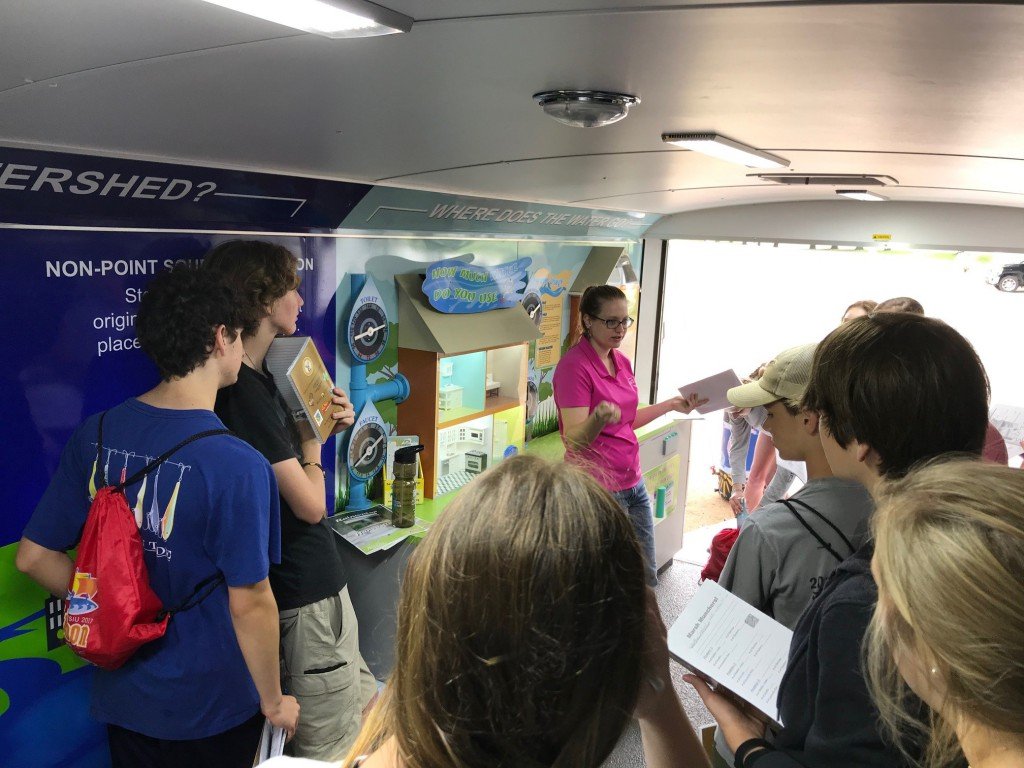
Michelle Wood-Ramirez recently asked some high school students how much water they use as part of their daily bathroom routine – How long are your showers? How many times do you flush? How often do you wash your hands? They were almost too embarrassed to answer.
But their self-conscious giggles flow into groans and expressions of shock after they are told the average shower uses 20 gallons of water a day, that most people send 18 gallons swirling down the toilet and use another 6 gallons washing their hands. That’s over 300 gallons a week.
 The students got this mind-blowing information while standing in the new Watershed Experience Trailer owned by the Tarrant Regional Water District. With its colorful, interactive displays the mobile classroom helps anyone who walks through it see where they fit into the water cycle and what they can do to conserve and protect water resources in the areas where they live.
The students got this mind-blowing information while standing in the new Watershed Experience Trailer owned by the Tarrant Regional Water District. With its colorful, interactive displays the mobile classroom helps anyone who walks through it see where they fit into the water cycle and what they can do to conserve and protect water resources in the areas where they live.
“They don’t know where their water comes from. They don’t know how much they are using. To them it is on and off,” said Wood-Ramirez, watershed coordinator for the Tarrant Regional Water District to the ninth-grade students from Fort Worth Country Day.
“They don’t have the landscape level concept of how they are part of the water cycle,” Wood-Ramirez said. “Hopefully we can get people to understand they are part of the cycle and their stewardship for the whole water cycle. Everyone lives in a watershed.”
The 24-foot-long trailer hit the road about a year ago and has already been dispatched to 16 schools and community events where an estimated 7,700 people walked through. The Watershed Experience Trailer cost about $75,000 and was developed by various departments at the District.
It shows what happens to water from the stream miles away to the stream coming out of the faucet, from lakes onto lawns.
“This trailer gives them a visual of how they, as an individual, can impact the big system and how collectively can take responsibility,” said Robin Hallford, a Texas Wildlife Association education program specialist.
“I think you can see the whole picture instead of one tiny piece of it and how it all adds up. It has a much bigger impact. Hopefully, it makes them more conscientious,” she said.
The trailer has four primary lesson dioramas or exhibits: What is a Watershed; a Rainfall Simulator; What’s in Your Watershed; and Where Does the Water Go?
The watershed exhibit, complete with a city and farmland below, shows how rainfall hits the ground and collects on the lowest level for future distribution. The rainfall simulator depicts how much rain is absorbed when it hits bare soil, native prairie, concrete, and a mowed lawn.
“The soil is like a sponge. One pound of healthy soil can hold almost 20 pounds of water,” Wood-Ramirez said.

The What’s in Your Watershed display explains how pollutants can enter into the water cycle, either from a pipe, ditch or channel or from stormwater erosion or runoff. It continues the global perspective on how rainfall and runoff interact with our environment.
The Where Does the Water Go section (subtitle: How Much Water Do You Use) brings home how much H2o people use. A cutaway of a house shows a kitchen, bathroom, and laundry room. Dials on bright blue pipes show usage by a toilet, faucet, washing machine and shower.
In front of the Country Day students, Wood-Ramirez quizzes the students about how long – and how many – showers they take. Do they leave the faucet running when they brush their teeth? How many loads of laundry do they imagine their family does a week?
Then, to stress how much water that is, Wood-Ramirez asks them how many gallon milk jugs they can carry and wonders what it would be like to bring the water to the home from a stream or community well. Imagine doing that for yourself or a family of four.
The average household uses 225 gallons a day, or 1,575 gallons a week.
“You’re going to have such a workout by the end of the week,” Wood-Ramirez joked. “This is real life, right?”
And this doesn’t include water for keeping the lawn green or the car clean, she said.
“Once they realize they are part of the watershed, they are going to act differently and change. They can see that they are part of the system and they are invested. It’s their water that is going to come out of the faucet,” Wood-Ramirez said.
Her lessons about water did not just roll off the back of Joaquin Castro-Balbi at Country Day. He said what he learned would lead to changes in his behavior. He said he has relatives overseas and knows how different – and complicated – their situations in access to water can be.
“I can see people wasting a lot of water,” Castro-Balbi said. “I personally don’t waste a lot. I’ve been aware of how much I use. But I have relatives and sometimes they have different situations so that I can learn from them as well.”


